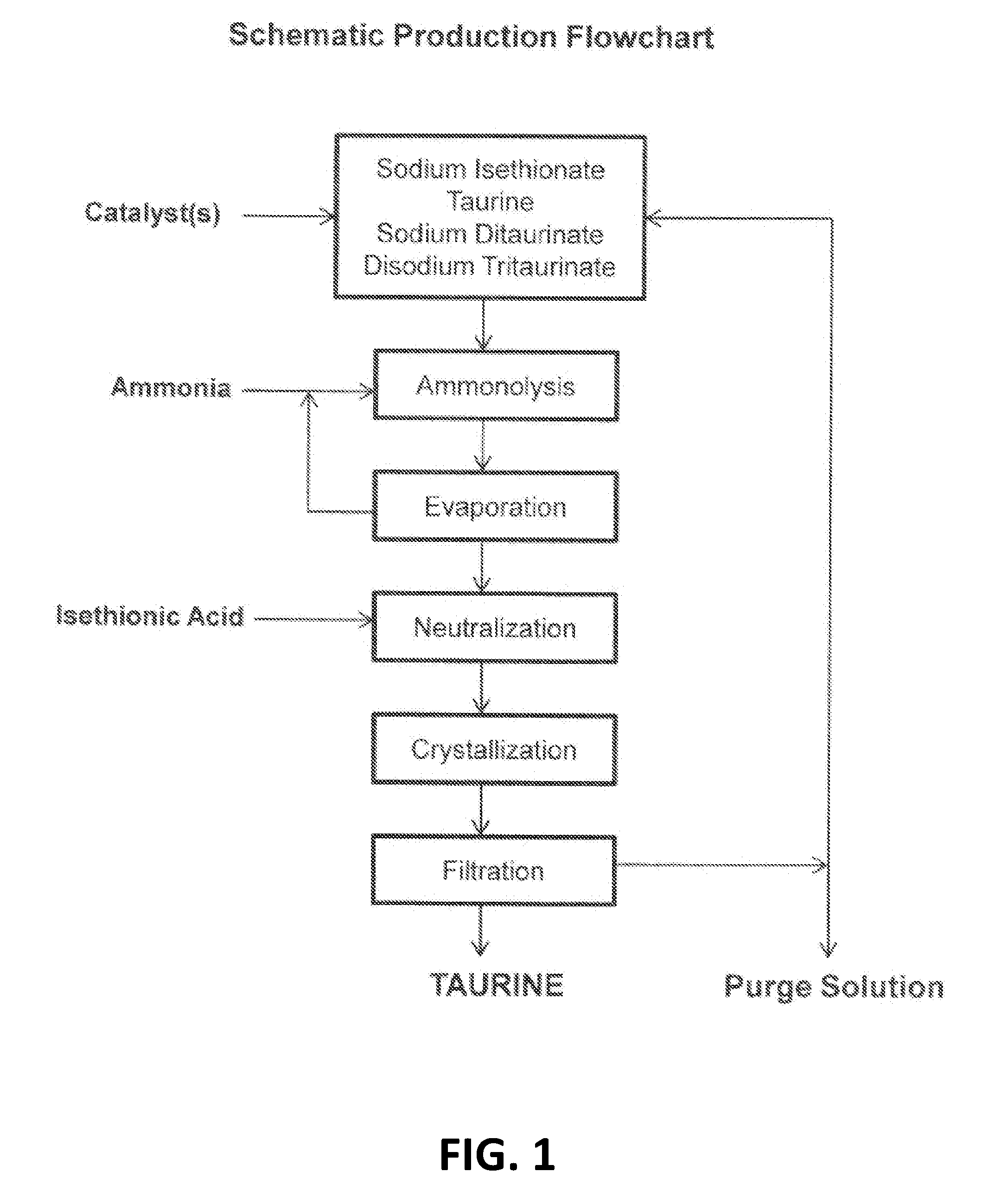Cyclic process for producing taurine
a cyclic process and taurine technology, applied in the field of cyclic process for the production of taurine, can solve the problems of large waste stream, low overall yield, and large waste stream, and achieve the effect of reducing the number of ethylene oxide production steps, increasing the difficulty of disposal, and increasing the difficulty of ethylene oxide production
- Summary
- Abstract
- Description
- Claims
- Application Information
AI Technical Summary
Benefits of technology
Problems solved by technology
Method used
Image
Examples
example 1
[0032]To a 2-L autoclave are added 1200 mL of 24% ammonia solution, 296 g of sodium isethionate, and 2 g of sodium hydroxide. The solution is heated to 260° C. for 2 hours under autogenous pressure. After removal of ammonia, 252 g of isethionic acid is used to bring the pH of the solution to pH 8. A suspension of crystalline taurine is obtained. After cooling to room temperature under slow stirring, taurine is recovered by filtration and dried to 188.6 g. Taurine is recovered in a yield of 75.4%.
example 2
[0033]To the mother liquor of Example 1 is added 340 g of gaseous ammonia and total volume is adjusted to 1500 mL with deionized water, followed by addition of 10.5 g of sodium hydroxide. The solution is placed in a 2-L autoclave and is subjected to ammonolysis reaction and treatment with isethionic acid as described in Example 1.
[0034]Taurine, 234.9 g after drying, is obtained in a yield of 93.1% on the basis of used isethionic acid.
[0035]The mother liquor after isolation of taurine, after being saturated with ammonia, is repeatedly subjected to the ammonolysis reaction in the presence of 15 g of sodium hydroxide 5 times for an overall yield of taurine of 96.4% on the basis of isethionic acid used.
example 3
[0036]This set of examples shows the effect of a different catalyst on the ammonolysis of regenerated sodium isethionate in the presence of a mixture of sodium ditaurinate and sodium tritaurinate obtained from the mother liquor of taurine crystallization.
[0037]All examples are for 0.05 mole of sodium isethionate, present in the mother liquor, dissolved in 35 mL of 20% aqueous ammonia solution in a molar ratio of 1:8 for sodium isethionate to ammonia. Calculated amount of catalyst are added to the solution. The ratio of (di+tritaurinate) / isethionate in the mother liquor is 0.3. The ammonolysis reaction is carried out in an 100 mL autoclave at 220° C. under autogenous pressure for two hours. The content of taurine, ditaurine, and tritaurine is assayed by HPLC analysis. The yields are calculated according to the following formula:
Taurinate Yield (%)=[Taurine] / [Sodium Isethionate]
TABLEEffect of Catalyst on Ammonolysis of Sodium Isethionate in the Presence of a Mixture of Sodium Ditaurin...
PUM
| Property | Measurement | Unit |
|---|---|---|
| temperature | aaaaa | aaaaa |
| molar ratio | aaaaa | aaaaa |
| pH | aaaaa | aaaaa |
Abstract
Description
Claims
Application Information
 Login to View More
Login to View More - R&D
- Intellectual Property
- Life Sciences
- Materials
- Tech Scout
- Unparalleled Data Quality
- Higher Quality Content
- 60% Fewer Hallucinations
Browse by: Latest US Patents, China's latest patents, Technical Efficacy Thesaurus, Application Domain, Technology Topic, Popular Technical Reports.
© 2025 PatSnap. All rights reserved.Legal|Privacy policy|Modern Slavery Act Transparency Statement|Sitemap|About US| Contact US: help@patsnap.com

